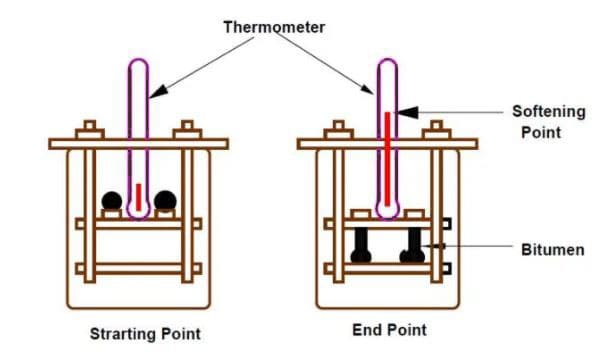The ring and ball test is used to determine the softening point of bitumen, asphalt, and coal tar. The test consists of two brass rings and two steel balls that are used to determine the softening points of various bituminous materials.
The softening point of bitumen or tar is the temperature at which the substance reaches a certain level of softening. As per IS: 334-1982, ASTM E28-67 or ASTM D36 or ASTM D6493 – 11, it is the temperature in ºC at which a standard ball passes through a sample of bitumen in a mould and falls through a height of 2.5 cm, when heated under water or glycerine at specified conditions of test. The binder should have sufficient fluidity before its applications in road uses.
Uses of Softening Point
In order to determine the temperature at which a bituminous binder should be heated for various road applications, the softening point must be determined. A ring and ball apparatus is used to determine the softening point.
Apparatus for Softening Point Test
-
Brass ring & Steel ball:
It consist of a metal frame having three plate and hole at the top of the plate for insertion of thermometer to measure temperature. The middle plate has two large hole for placing of ring ball and a small hole at the middle of plate. The lower plate of metal frame does not have any hole. The distance between top surface of bottom plate and lower surface of middle plate is 25 millimeter. - A cylindrical ring is tapered in shape. The diameter of the top ring is 17.5 millimeter and its height is 6.4 millimeters.
-
The centering guide has three pins such that they form an imaginary circle if diameter slightly larger than 7.5 millimeters to enable movement of steel ball.
The centering guide and the ring re fit with each other and place on the metal frame. - The steel ball has diameter 7.5 millimetre and its weight is 3.5 gram.
- Heat resistance beaker of capacity 600 ml.
- A thermometer having a range of more than 120 degrees centigrade and accuracy not less than 0.5 centigrade.
- Heat regulator


Procedure for Softening Point Test on Bitumen
- Preparation of test sample Heat the material to a temperature between 75-100° C above its softening point; stir until, it is completely fluid and free from air bubbles and water. If necessary, filter it through IS sieve 30. Place the rings previously heated to a temperature approximating to that of the molten material, on a metal plate which has been coated with a mixture of equal parts of glycerine and dextrin. After cooling for 30 minutes in air, level the material in the ring by removing the excess material with a warmed, sharp knife.
- Assemble the apparatus with the rings; thermometer and ball guides in position
-
Fill the bath with distilled water to a height of 50mm above the upper surface of the rings. The starting temperature should be 5° C.
Note: Use glycerin in place of water if the softening point is expected to be above 80° C; the starting temperature may be kept 35° C. - Apply heat to the bath and stir the liquid so that the temperature rises at a uniform rate of 5 ± 0.5 °C per minute.
- As the temperature increases the bituminous material softens and the balls sink through the rings carrying a portion of the material with it.
- Note the temperature when any of the steel balls with bituminous coating touches the bottom plate.
- Record the temperature when the second ball touches the bottom plate. The average of the two readings to the nearest 0.5°C is reported as softening point.
Materials for Softening Point Test
Following materials used in softening point test of bitumen:
- Bitumen to be tested
- Glycerine
- Dextrine
- Distilled water- for heating medium
Precautions During Softening Point Test
- Distilled water should be used as the heating medium.
- During the conduct of test the apparatus should not be subjected to vibrations.
- The bulb of the thermometer should be at about the same level as the rings.
Recommended Values of Bitumen Softening Point
Binders are characterized by the same viscosity at the same temperature as those at their softening point. Bituminous materials do not melt. Rather, the transition from solid to liquid occurs gradually over a wide range of temperatures. Joint and crack fillers have a particular importance in terms of softening point. Fillers with a high softening point will not flow during service. The higher the softening point, the lower the temperature sensitivity. Bitumen with a higher softening point is preferred in warmer climates.
Significance of softeneing point test
- The bitumen softening point identifies the temperature beyond which bitumen is softened beyond a pre-specified level.
- Therefore, the softening point test of bitumen helps in determining the maximum temperature to which the given bitumen can be exposed.
- In road construction, this is used as a binder for bitumen. A softening point value indicates the temperature at which bitumen should be heated before it is used in paving.
- As the climatic temperature exceeds the softening point, the bitumen used as a binder starts to melt, making the pavement sticky.
